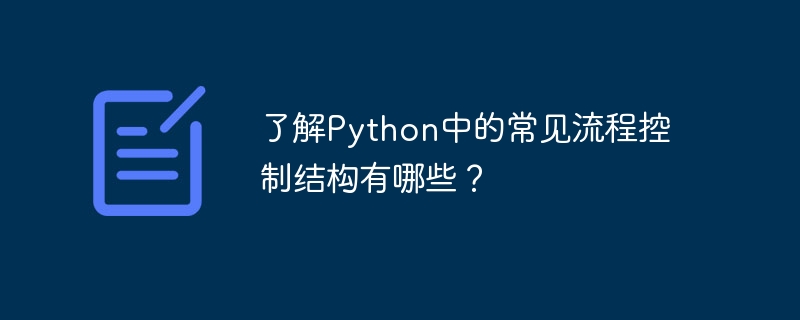Home >Backend Development >Python Tutorial >What are the common flow control structures in Python?
What are the common flow control structures in Python?
- WBOYWBOYWBOYWBOYWBOYWBOYWBOYWBOYWBOYWBOYWBOYWBOYWBOriginal
- 2024-01-20 10:05:07514browse

Understand what are the common process control structures in Python?
Python is a concise and powerful programming language that provides a variety of flow control structures that enable programs to execute code in different ways. In this article, we will introduce several common flow control structures in Python and provide corresponding code examples.
-
Conditional statements (if statements)
Conditional statements allow selective execution of blocks of code based on given conditions. In Python, the syntax of an if statement is: if condition:code to be executed elif condition: code to be executed else: code to be executed
The following is a simple example that demonstrates using an if statement to select a block of code to execute based on a condition:
x = 10
if x > 0:
print("x是正数")
elif x < 0:
print("x是负数")
else:
print("x是零") - Loop statements (for loops and while loops)
Loop statements allow a block of code to be executed repeatedly until a certain condition is met. In Python, there are two common loop statements: for loop and while loop.
Use a for loop to iterate elements in a sequence or iterable object. The syntax is: for variable in sequence:
code to be executed
The following is a for loop that uses a for loop to output elements in a list. Example:
fruits = ["apple", "banana", "cherry"]
for fruit in fruits:
print(fruit)Use a while loop to repeatedly execute a block of code when a condition is met. The syntax is: while condition:
code to be executed
The following is an example of using a while loop to calculate the cumulative sum of numbers:
sum = 0
i = 1
while i <= 10:
sum += i
i += 1
print("1到10的累加和为:", sum)- Control statements (break statement and continue statement)
Control statements are used to control the execution of code in a loop. In Python, two common control statements are break and continue.
Use the break statement to terminate the loop early, jump out of the loop body, and continue executing the code after the loop. The following is an example of using the break statement to find a specified element in a loop:
fruits = ["apple", "banana", "cherry"]
for fruit in fruits:
if fruit == "banana":
print("找到了香蕉!")
break
print(fruit)Use the continue statement to skip the remaining code of this loop and enter the next loop. The following is an example of using the continue statement to skip certain elements in a loop:
fruits = ["apple", "banana", "cherry"]
for fruit in fruits:
if fruit == "banana":
continue
print(fruit)To sum up, the above are several common flow control structures in Python, including conditional statements (if statements), Loop statements (for loop and while loop) and control statements (break statement and continue statement). Understanding and skillfully applying these process control structures can make our programs more flexible and efficient.
The above is the detailed content of What are the common flow control structures in Python?. For more information, please follow other related articles on the PHP Chinese website!

